inflation pressure VOLKSWAGEN JETTA 2007 Owners Manual
[x] Cancel search | Manufacturer: VOLKSWAGEN, Model Year: 2007, Model line: JETTA, Model: VOLKSWAGEN JETTA 2007Pages: 477, PDF Size: 77.6 MB
Page 373 of 477
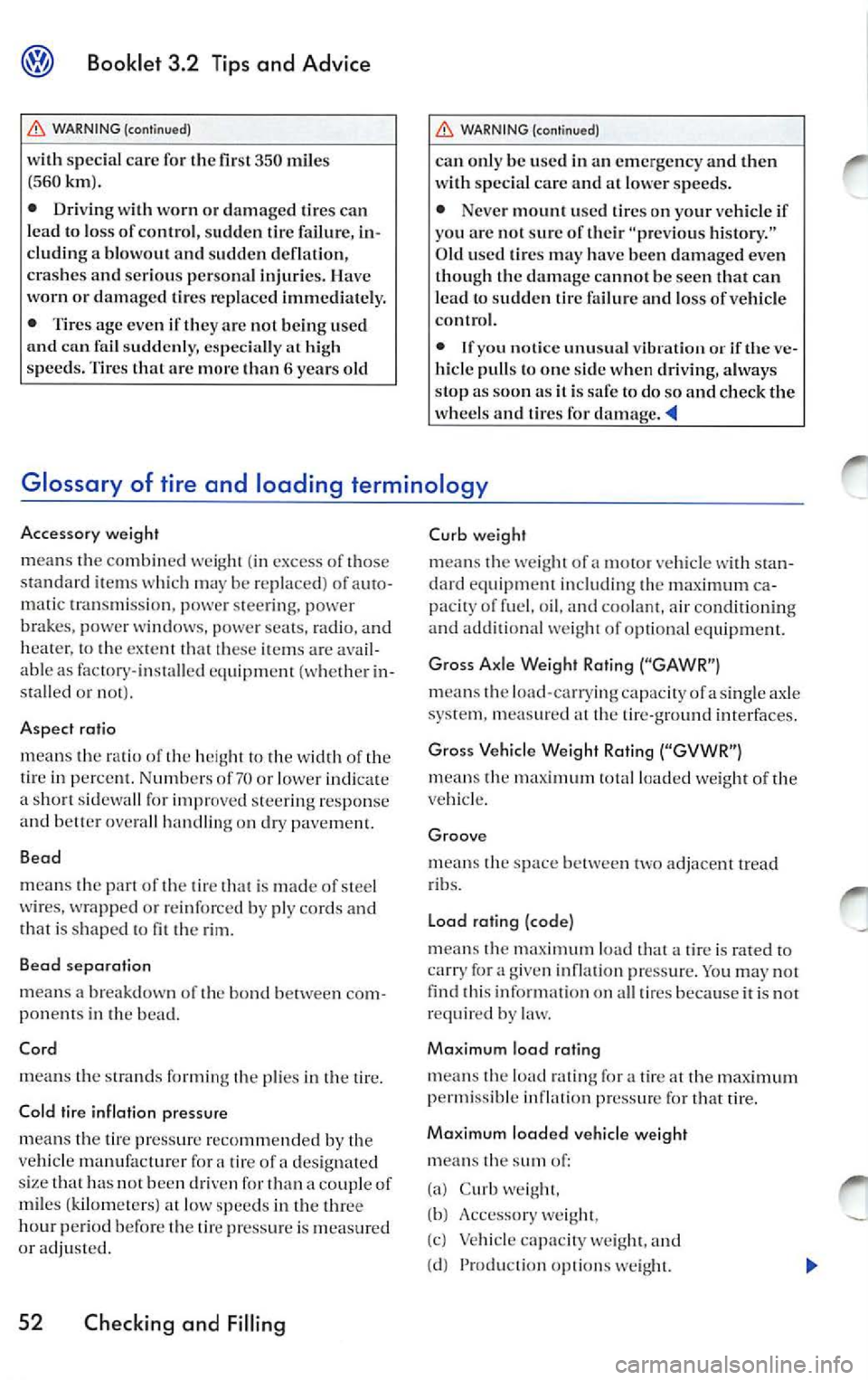
Booklet 3.2 Tips and Advice
WARNING (continued)
with special care for the fir st 35 0 mile s
( 560km ).
• Driving with worn or dam aged tires can
l ead to los s of co ntrol, sud den tire failure, in
clud ing a blowout and sudden deflation,
cras hes and se riou s perso nal injurie s. H ave
worn or damaged tires rep laced immediat ely.
• Tires age even if th ey arc not bein g used
a n d can fail sudd enl y, es pecia lly
at high
s p ee ds. Tire s th at ar c mor e than 6 yea rs old
WARNIN G (contin ued)
ca n onl y be use d in an em erge ncy and then
w ith specia l ca re and at lo w er sp eeds.
• Neve r m ount u sed t ires on yo ur vehicl e if
you arc not s ure of th eir "pre vio us hi story."
Old use d tir es ma y have been dama ged eve n
t h ough th e damage cann ot b e see n that can
l ea d to sudd en tir e fa ilur e and loss of vehicle
contro l.
• If yo u notice unu sual vibrat ion or if th e ve
hicle pull s to one sid e wh en drivin g, a lways
stop as soo n as it is safe to do so and check the
wheels and tires for dam age.
Glossary of tire and loading terminology
Accessor y weight
m ea ns th e comb ined weigh t (in excess of those
s tand ard item s wh ic h may b e re p laced ) of auto
matic tran sm iss ion, powe r stee ring . power
brake s, pow er wind ows, powe r se ats. radio, a nd
heat er, to th e ex tent that th ese item s are ava il
ab le as factory- in st all ed eq ui pment (w heth er in
s talled or not).
Aspect ratio m ea ns th e ra tio of th e heig h t
th e wid th of th e
ti re in perce nt. Numbers of70 or lowe r ind icat e
a sh ort sid ewa ll for imp roved steering r espons e
a nd be tter ove rall hand ling d ry pa vement.
B ead
m ea ns th e pan oft he tire that is m ade of stee l
w ires, wrapp ed or reinfor ced by ply cords and
t h at is s hape d to
th e rim .
B ead separation
mean s a breakdow n of th e bo nd b etwee n com
p on ent s in the bea d.
Cord mea ns th e s trands for ming the plies in t he tire .
Cold lir e inflation pressure
m ea ns th e tire press ure reco mmend ed by the
ve hicl e m anu factur er f or a tire of a des ig nate d
s ize th a t ha s not b ee n d rive n for th an a co up le of
m iles ( kilomete rs) at low sp eeds in th e thr ee
h our peri od befo re th e tire press ure is m eas ured
or ad juste d.
52 Checking and Filling
Curb weig ht
mea ns th e weig ht of
a moto r ve hicle sta n
dard equipm ent in cluding th e maxi mum ca
paci ty o f fuel. oil. a nd coolant, air co ndition ing
and additional weight of o ptional equipme nt.
Gr oss Axle Weight Roting
m ea ns th e load -ca rryi ng ca pacity of a sin gle axle
sys tem, measured at th e tire-gro und in te rface s.
Gro ss Vehicl e W eight Roling
means th e max imum t otal load ed weig ht of the
ve hicl e.
Groo ve
m ea ns th e spa ce betw een
ad jacent tread
r ib s.
L o ad rotin g (cod e)
m eans the maximum load that
tir e is ra ted to
carry for a given inflation press ure. You may not
this o n all tir es bec ause it is not
required by law.
Ma ximum load roting
m ean s th e load rating for
tire at th e perm iss ible inflatio n pressu re for that t ir e .
Ma ximum load ed ve hicle weig ht
mean s th e
of:
(a) C urb weig ht,
( b ) Accesso ry weight,
( c ) Vehicle capa city weigh t, a nd
(cl ) Pro duction o ptions we ig h t.
Page 374 of 477
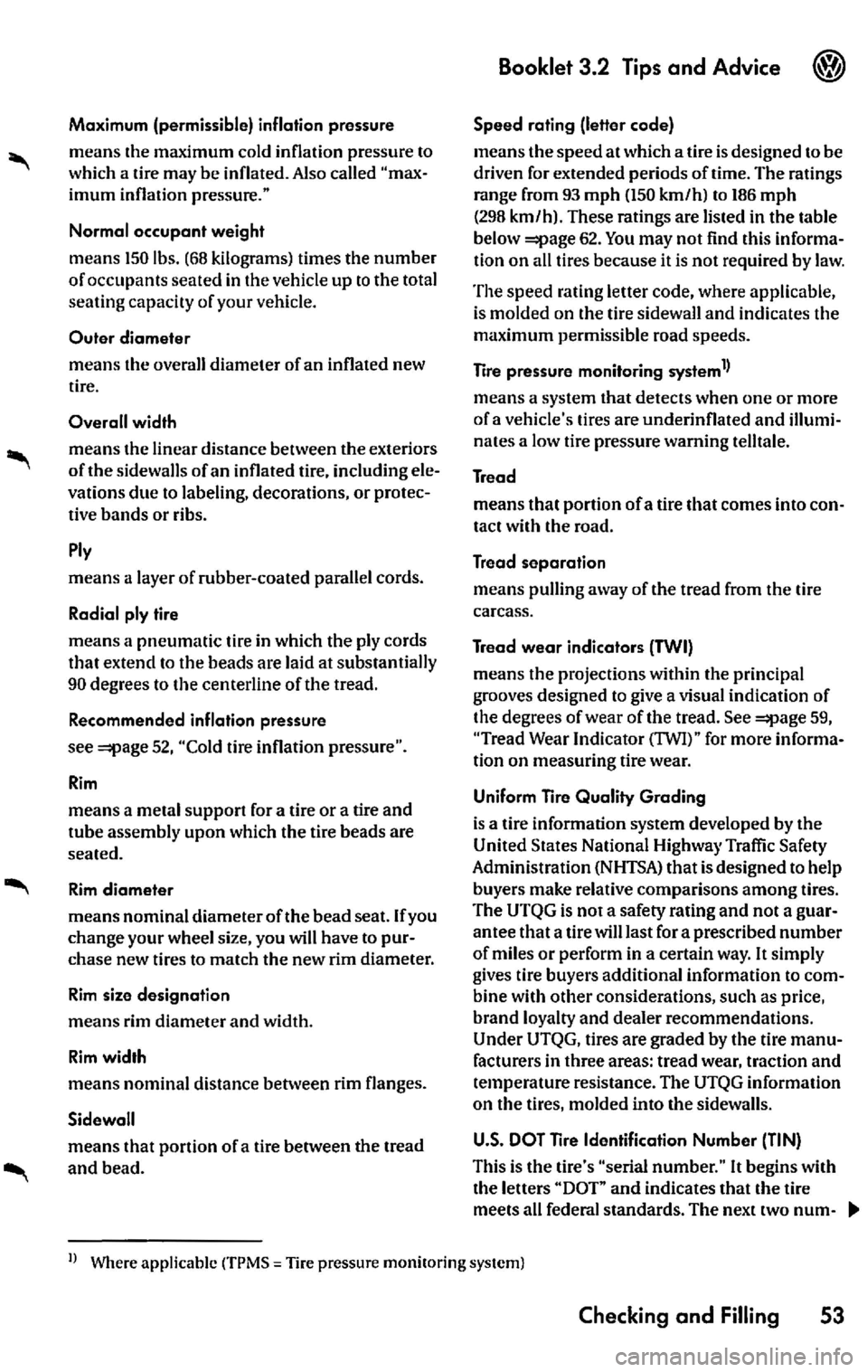
Maximum (permissible) inflation pressure means the maximum cold inflation pressure to
which a tire may be inflated. Also called "max imum inflation pressure."
Normal occupant weight
means
150 lbs. (68 kilograms) times the number
of occupants seated in the vehicle up to the total seating capacity of your vehicle.
Outer diameter
means the overall diameter of an inflated new
tire.
Overall width means the linear distance between the exteriors
of the sidewalls of an inflated tire, including ele
vations due to labeling, decorations, or protec tive bands or ribs.
Ply
means a layer of rubber-coated parallel cords.
Radial ply tire
means a pneumatic tire in which the ply cords
that extend to the beads are laid at substantially
90 degrees to the centerline of the tread.
Recommended inflation pressure
see
52, "Cold tire inflation pressure".
Rim
means a metal support for a tire or a tire and
tube assembly upon which the tire beads are
seated.
Rim diameter
means nominal diameter of the bead seat . If you
change your wheel size, you will have to pur
chase new tires to match the new rim diameter.
Rim size designation
means rim diameter and width.
Rim width
means nominal distance between rim flanges.
Sidewall
means that portion of a tire between the tread
and bead.
Booklet 3.2 Tips and Advice
Speed rating (letter code) means the speed at which a tire is designed to be
driven for extended periods of time. The ratings range from 93 mph (150 km/h) to 186 mph
(298 km/h). These ratings are listed in the table
below 62. You may not find this informa
tion on all tires because it is not required by law.
The speed rating letter code, where applicable, is molded on the tire sidewall and indicates the
maximum permissible road speeds.
Tire pressure monitoring system
1 )
means a system that detects when one or more
of a vehicle's tires are underinflated and illumi nates a low tire pressure warning telltale.
Tread means that portion of a tire that comes into con
tact with the road.
Tread separation means pulling away of the tread from the tire
carcass.
Tread wear indicators (TWI) means the projections within the principal
grooves designed to give a visual indication of
the degrees of wear of the tread. See
59, "Tread Wear Indicator (TWI)" for more informa
tion on measuring tire wear.
Uniform Tire Quality Grading
is a tire information system developed by the United States National Highway Traffic Safety
Administration (NHTSA) that is designed to help buyers make relative comparisons among tires.
The UTQG is not a safety rating and not a guar antee that a tire
will last for a prescribed number
of miles or perform in a certain way. It simply
gives tire buyers additional information to com bine with other considerations, such as price,
brand loyalty and dealer recommendations .
Under UTQG, tires are graded by the tire manu
facturers in three areas: tread wear, traction and temperature resistance. The UTQG information
on the tires, molded into the sidewalls.
U.S. DOT Tire Identification Number (TIN)
This is the tire's "serial number."
It begins with
the letters "DOT" and indicates that the tire
meets all federal standards. The next two num-
Tire pressure monitoring system)
Checking and Filling 53
Page 375 of 477
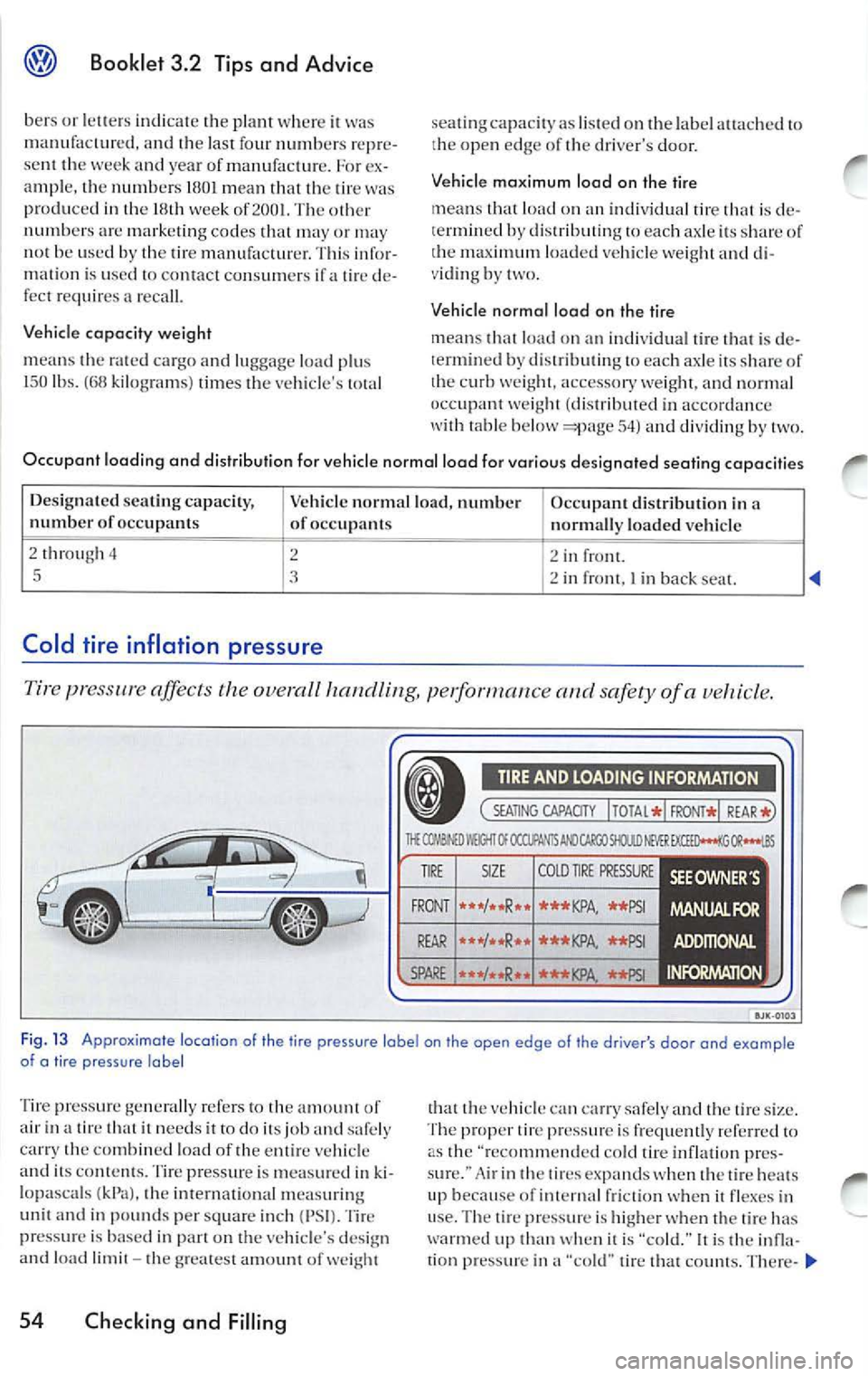
Booklet 3.2 Tips and Advice
bers or w her e il manufactured, and fo ur numb ers re pre
s ent the week and year of manufa ctur e. For ex
ampl e, th e numb ers 180 1 m ean lhal
lir e produ ced in the wee k of 200 1. oth er
numb ers arc m ark e ting code s may or may
n ot b e use d by th e lir e m an ufa c tur er. T hi s info r
is use d lO cl co nsum ers if lir e dere quir es reca ll.
Vehicle capacity we ight
means cargo and luggage load pl us
1 50 lbs. (68 kilogra ms) lime s vehicle's I se
alin g capaci ty as
on label alt ached lo
t h e open ed ge of th e dri ver's door .
Vehicle maximum load on the tire
means that load on an ind iv idua l tire that is de
t erm in ed b y dis tribu ting e a ch ax le its shar e of ma ximum load ed ve hicle weig ht and di
v iding b y
Vehicle nor mal load on the tire
mean s load on an indi vidual lha l is de
termined by each axle i ls s hare of curb accessory and n ormal weighl in accordan ce below 54) and div id in g by
Occupant loading and distribution for vehic le normal load for various designated sealing capaciti es
Desig na ted sea ling capaci ty,
Vehicle norm al l oad, numbe r
Occupa nt distri bution in a
nu mber of occ upants
of occupants normally lo aded vehicle
2 th rough 4
2 2 in front.
5 3 in I in back scat.
Cold tire inflation pressure
pressure aff ects the overall safety of a icle .
TIRE AND LOADING INFORMATION
( SEATING CAPAOTY
amt,l D Of
TIR E SIZE COLD TIRE PRESSURE
FRONT
SPARE
F ig . 1 3 Approximate location of fire pressure labe l on open edge of driver's door and example
of a fire pressure label
T ire p ress ur e ge nera lly refe rs to in a tire th at i l needs il t o do ils job an d sa fe ly
ca rry co mbin ed loa d of enti re vehicle
and it s content s. Tir e pre ssur e is meas ured in ki
l op ascals
imernat io nal meas urin g
unit and in poun ds per squar e in ch (P SI). Tir e
p ressure is based in pan o n th e ve hicle's des ig n
and l oad Ii mil -
greates t amount of
54 Checking and Filling
th at can car ry safe ly an d th e lir e s ize.
T he proper tir e press ure is frequ entl y to
as the "recom mend ed co ld tire inflation pr es
s ur e." Air in
!ires expa nds w hen tir e heat s
up because of fric tion when it fl exes in
u se . Th e tir e press ure is highe r w hen tire warmed up than when is "co ld.·· ll i s infla
t io n p ressure in a "co ld" lire Ther e-
Page 376 of 477
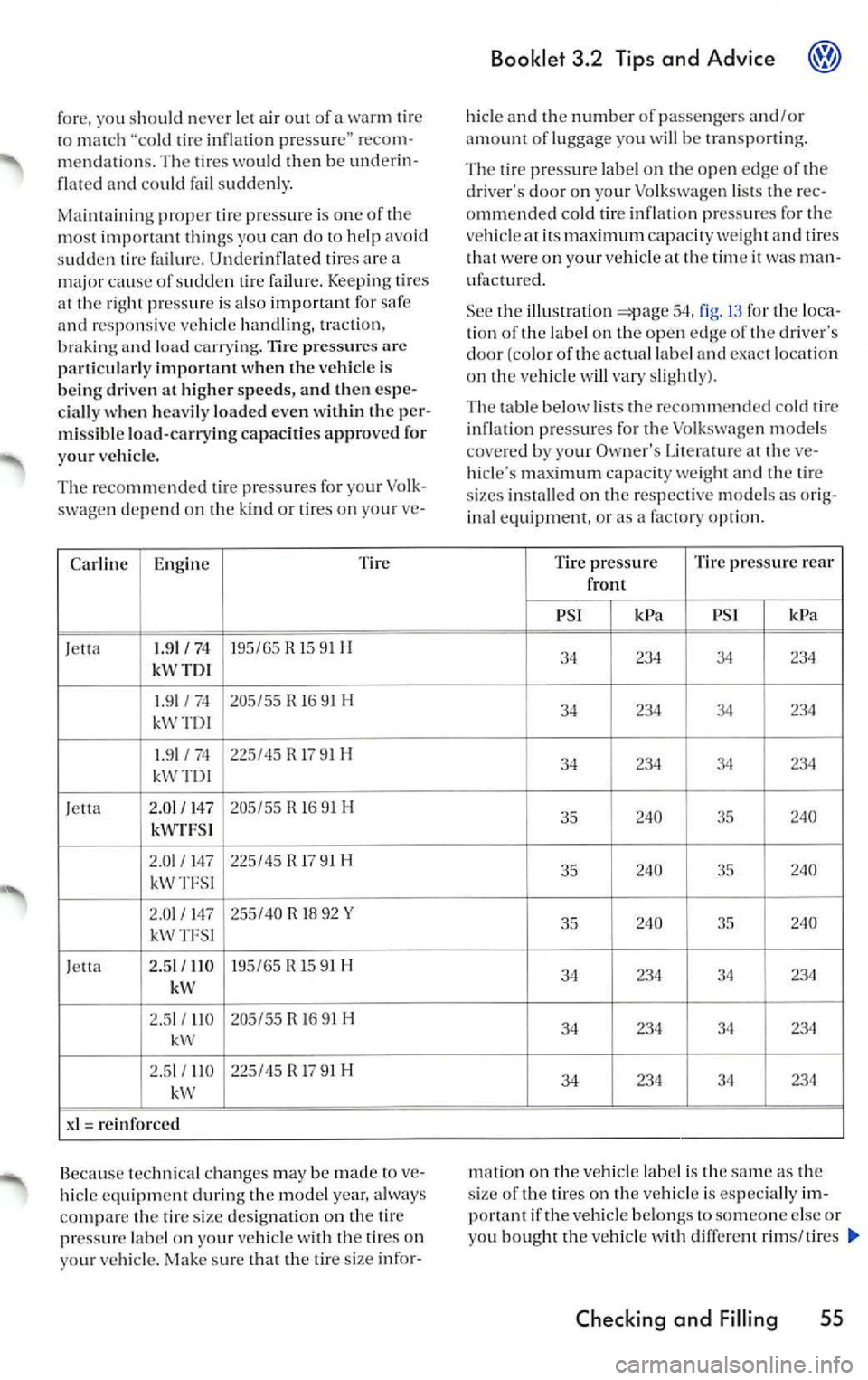
fore, you shou ld ne ver let air o ut of a warm ti re m atc h "cold tire inflation pressure" reco m
m endati ons. The tir es wo uld then be und erin
fla ted and could fail suddenl y.
Maint aining proper tire press ure is on e of the
mo st important things you ca n do
help avoi d
s udd en tir e failu re. Unde rinflated tire s are a
major cause of sudden tir e failure. Keeping t ires
a t th e righ t p ress ure is also important for saf e
and resp o nsiv e ve hicl e handl ing, tra ctio n,
and load carryi ng. Tire pre ssure s arc
part icu lar ly i mport ant when the ve hicle is
being driven at higher speeds, and then espe
cially when heavi ly lo ad ed eve n wit hin th e per
mi ssible load-carry ing capaci ties approved for
yo ur vehicle.
The reco mm end ed tir e pre ssure s fo r yo ur Volk
sw age n dep end on th e kind or tires on your ve-
Ca rlin e E ngin e Tire
Jet ta 1.91
/ 74 195/65
15 91 H
kWT DI
1.91/ 74 205
/55 R 16 91
kW TD I
1. 9 1 / 74 225/45
17 91 H
kW TDI
J etta 2.0
l / 147 205/55 R 16 911-1
2. 0l / 147 225/45
R 17 91 H
kWTF SI
2.0 1 / 147 255 /40
18 92 Y
kWTFSI
J e tt a 2.51/ 110 195/65
1 5 91 H
kW
2 .5 1 /
IIO 205/55 R 16 91 H
k W
2 .5 1 /
IIO 225/45 R 1791 H
kW
xi= reinfor ced
Be caus e
ch anges may be mad e to ve
hicl e equipm ent during the model year, always
c ompar e th e tire size designation on the tire
pr ess ure label on yo ur vehi cle
the tire s on
y ou r ve hicle. Make sur e that th e tir e s ize in fo r-
Booklet 3.2 Tips and Advice
hide an d th e number of passe ngers and /or
amo unt of luggage you will b e
The tire pr ess ure la b el on the op en edge of the
dri ver's doo r on your Volk swagen li sts th e rec
o mmended cold tire infla tion press ures fo r the
veh icle at its max imum capaci ty weight and tire s
th at were on your vehicle at the time it was man
ufa ctur ed.
See the illu stration
54, fig. for the loca
ti on of the label on the open edge of the drive r's
door (color of th e actual label and exact location
o n the vehicl e will vary slightl y).
table below li sts the recom mend ed co ld tire
inflation pressures for the Volk swa gen m odel s
cove red by your O wner's Lit era ture at the ve
hi cle's maximum capacit y weig ht and the tir e
s izes insta lled on th e res pec tive mode ls as ori g
in al e quipment , o r as a fa ctory opt ion .
Tire pressur e Tire pressure rear
front
PSI kPa
PS I kPa
34 234 34 234
34 234 34 234
34 234 34 234
3 5 240 35 240
35 240
35 240
35 240
240
34 234
34 234
34 2
34 3 4
234
34 234
34 234
mation o n the vehicl e lab el i s the same as th e
s ize of t he tir es on the ve hicl e is es pecially im
portan t if th e ve hicl e belo ngs to someo ne e lse or
y ou bou ght the vehicle with different rims/tires
Checking and Filling 55
Page 377 of 477
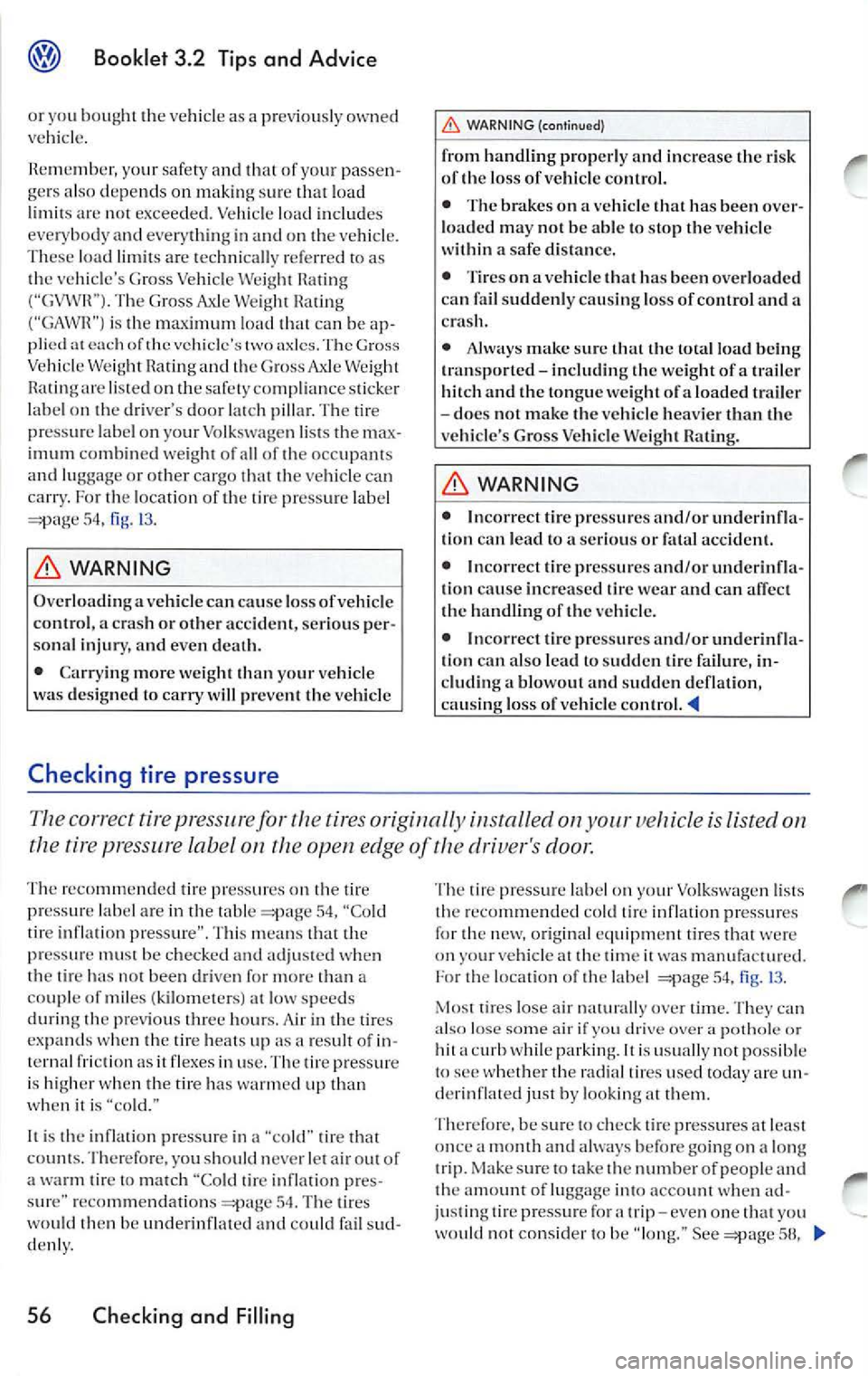
Booklet 3.2 Tips and Advice
or you bought the vehicle as prev iously owned
vehicle.
R emember, yo ur safety and that of your passen
ge rs also depends on making sure that load
limit s ar c not exceeded. Ve hicle load includ es
every body and every thing in and on the vehicl e.
These lo ad limit s are t echni cally r efer re d to as
th e ve hicle's Gross Vehicle Weight H ating
The Gross Axle We ight Hating is th e maximum load that can be ap
plied each of the vehicle' s two axl es. The Gross
V ehicl e Rating and the Gross Axle Weight
Ratin g ar c listed on the safety compliance stick er
lab el o n the driver's door
pillar. The tire
pre ssure lab el on your Volkswagen lists the max
imum combined w eight of a ll of the occupants
and lug gage or other cargo that the vehicle can
carry . For the location of the tir e pr ess ure lab el
54, 13 .
WARNING
Over loa din g a vehicl e can cause loss of vehicle
control, a cras h or other accident, serious per
so nal injury, and even death.
• Carrying more weight tha n yo ur vehicle
was des ig ned to carry
will pr event the vehicle
Checking tire pressure
WARNING (continued)
from handling properly and increase the risk
o f th e lo ss of vehicl e con trol.
• Th e brakes on a vehicle th at has been over
l oaded may not be able to stop the vehicl e
w ithin a sa fe dis tance.
• Tire s on a ve hicle that has been overloaded
can fail suddenl y caus ing loss of control and a
crash.
• Always make sure that the total load being
tran sport ed - includin g the weig ht of a tra iler
hit ch and the tongue weig ht of a loaded trailer
docs not m ake the vehicle h eavier than the
ve hicle' s Gross Veh icle We ig ht Rating.
WARNING
• Inco rrect tire and/or underinfla
t io n can lead to a se rious or fata l accident.
• Inco rrec t tire pr essures and/or underin fla
t ion cause increased tire wea r an d ca n affect
th e handling of the ve hicle.
• Incorrect tir e pre ssur es an d/o r underi nfla
t ion can also lead to s udden tire failure, in
cluding a blowo ut and sudd en deflation,
ca usi ng loss of ve hicl e
correct pressur e for tires originally i 11stalled on your icle is listed on
the tire pressure label on the open edge of
doo1:
Th e recomme nded tire pr essures on the tire
pr ess ure labe l ar e in the table "Co ld
tire inflation pres sure''. Thi s m ea ns that the
pre ssure mu st b e checked and adjusted when
th e tire
n o t bee n driv en for more than a
co uple of mil es (k ilometer s) at low spee ds
during the pr evious three hours. /\ir in the tire s
e xpands when the tire heat s up a s
res ult of in
ternal fr ic tion as it flexes in use. The tir e pressure
i s hig h er whe n the tire ha s wanned up than
wh en it i s ··co ld."
It is the inflation pre ssure in
tir e that
co unt s. Therefo re , yo u shou ld never le t air out of
tir e to match tir e inflati on pres
s ure·· recomme ndations 54. T he tires
would then be underinfl ated and could fa il sud
d enl y.
56 Checking and Filling
The tir e pressure label on your Volkswag en lists
th e reco mmended cold tire inflation pressure s
fo r th e new, original equipm ent tir es that were
on your vehicl e at the tim e it was manufa ctur ed.
the loca tion of the lab el 54, 13 .
Most tires lose a ir naturall y over time. Th ey can
also lose some air if yo u dri ve over a pothole
hit a curb wh ile parkin g. It i s usually not possib le
to sec whether the radial tires used today ar e un
clcrinflated just hy looking
th em.
T herefo re, be sur e to chec k tire press ures at l eas t
o nce a month and always before going on
long
trip. Make sur e to tak e th e numb er of people and
th e amount of luggage into account when ad
ju stin g tir e pr ess ure for a trip-even o ne that you
not cons ider to be Sec
Page 414 of 477
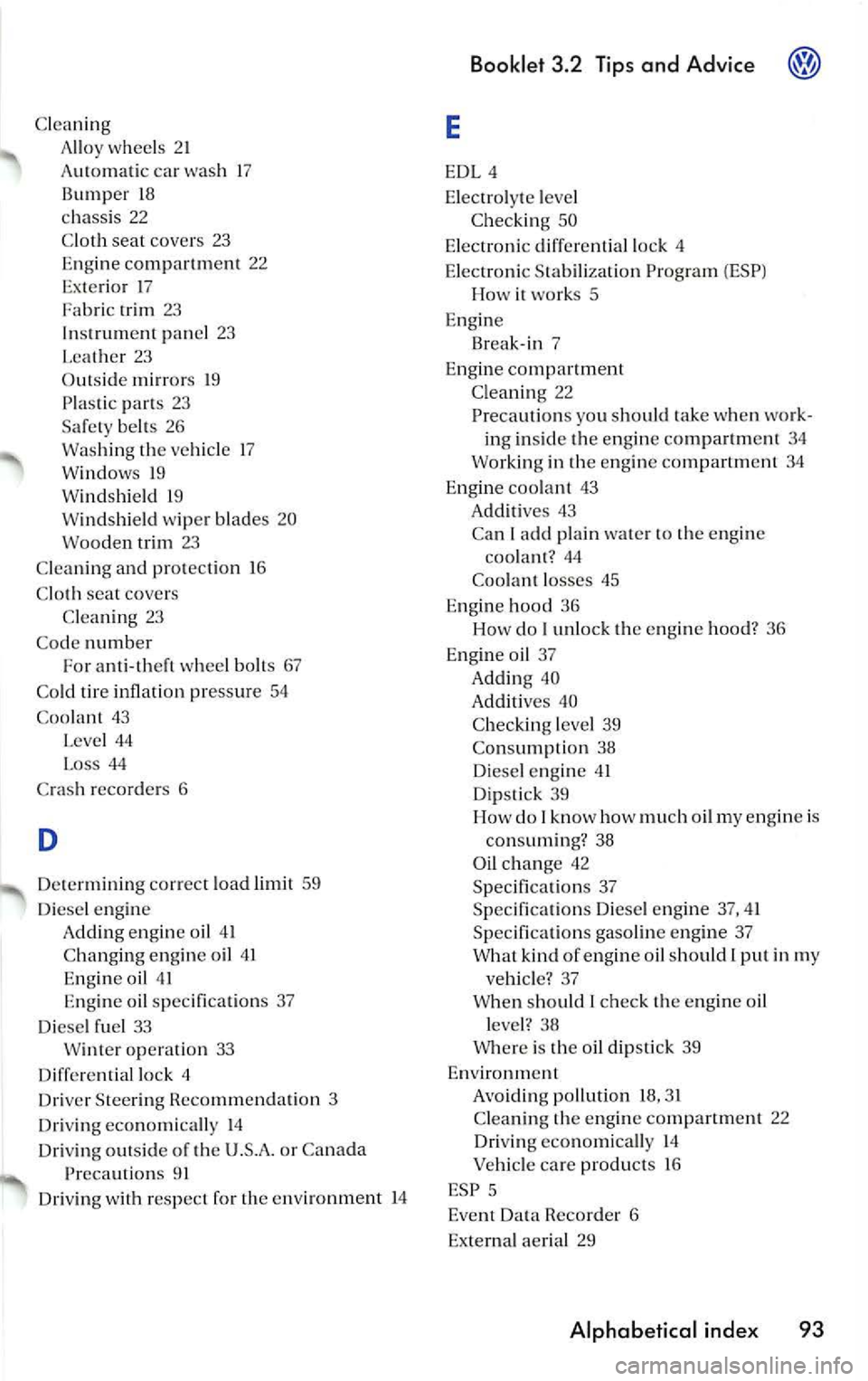
Cleani ng
A llo y whee ls
2 1 A ut omati c car was h 17
Bump er
18
chassis 22 C lo th sea t cove rs 23
E n gin e co mpartm ent 22
Ex ter ior 1 7
trim 23
In stru ment panel 23
L ea th er 23 Out side mir rors 19
P las tic 23
bel ls 26
W ashin g the ve hic le 1 7
W ind ows 19
Wind sh ie ld 19 W ind shie ld wip er blad es 20
W ooden trim
23
Cle an ing and pro tec tio n 16
C lot h sea t cove rs
C le an ing
23
Code number
Fo r
whee l bolt s 67
Cold tire inflation pressure 54
Coo la nt 43 Le ve l 44
Loss 44
Cra sh recorder s 6
D
Deter minin g corre ct load limil 59
D iese l e ngine
Ad din g en gi ne oil 41
C hang ing engin e oil 41
En gin e oil 4 1 Engin e oi l 37
Die se l fu el 33 Wi nte r operat io n 33
D iffe re nti al loc k 4
Drive r Stee ring Recomme ndati on 3
Dr iv in g eco nomi cally 14
Driv ing ou1 sid e o f !h e U.S. A. or Canada
P rec au1io ns
9 1
Driv ing wit h respec t for th e en vironme nt 14
Booklet 3.2 Tip s and Advice
ing in sid e 1h e e ng in e c om pa rtm en t 34
Wo rkin g in th e engin e com partmen t 34
Engin e coola nt 43
Add iti ves 43
Can I acid p la in wate r the engi ne
coo lan t?
44 Coola n! losses 45
Eng ine hoo d 36
How do I unlock !he en gin e hoo d? 36
Eng ine oil 37
Add ing 40
Addit ives 40
C he ck in g leve l 39
Consu mplion 38
Die sel e n gine 4 1
Dips!i ck 39 H ow do I kn ow how much oil m y eng in e is
co nsum ing?
38
Oi l cha nge 42
Specifica tions 37 Spec ifi ca tions Diese l eng in e 37 , 4 1
Spec ifica !io ns gaso li n e e ngi ne 37 W hal kind of e n gin e oi l s h o uld I p u ! in my
v eh icl e?
37
W hen sh o ul d I ch eck !he e ngin e oi l
l eve l? 38 W here is th e oil dip stick 3 9
E nvironm en t
Avo iding polluti on 31
C le anin g th e e ngine compa rtment 22 Driving economically 14
V ehi cle care produ cts 16
ES P 5
Eve nt Dat a Reco rde r 6
Ex terna l ae rial 29
Alphabetical index 93